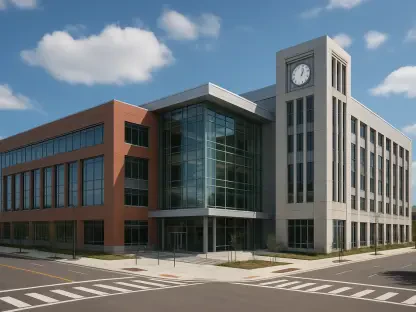Luca Calaraili is an expert in Construction, with extensive knowledge in design and architecture. He is also passionate about exploring technology applications and tools that drive innovation within the industry. Today, we will discuss the North American limestone market, its current state, future projections, and the factors at play.
Can you provide a brief overview of the North American limestone market as of 2024?
The North American limestone market was valued at USD 26.88 billion in 2024. The market is primarily driven by the construction industry, with the United States holding about 85% of the market share. This dominance is due to both production and consumption, reflecting its critical role in infrastructure and environmental management.
What are the projections for market growth by 2033?
The North American limestone market is forecasted to grow at a compound annual growth rate (CAGR) of 7.27%, reaching an estimated value of USD 50.58 billion by 2033. This growth is driven by rising demand in construction, environmental applications, and technological advancements.
What role does the United States play in the North American limestone market?
The United States is a major player, accounting for approximately 85% of the market share. This is due to extensive limestone resources, a strong demand for construction materials, and significant investments in mining technologies that enhance extraction efficiency.
How significant is the construction industry’s demand for limestone in North America?
The construction industry is a major consumer of limestone in North America, utilizing it primarily for cement production and infrastructure projects. Over 60% of limestone is used in construction, demonstrating its crucial role in urbanization and building endeavors.
What factors are driving the increased demand for limestone in the construction industry?
Increased demand stems from the construction industry’s reliance on limestone for cement and road construction. Infrastructure spending and urbanization, coupled with rising housing and commercial construction projects, significantly drive this demand.
How does urbanization impact the demand for limestone in North America?
Urbanization leads to increased infrastructure development, which in turn raises the demand for limestone. As cities expand and new construction projects start, the need for materials like limestone for cement and base materials grows accordingly.
Can you elaborate on how advancements in mining technologies have reduced limestone extraction costs?
Advancements in mining technologies have led to a 15% reduction in limestone extraction costs. This includes improvements in extraction efficiency and cost-effective methods, making the process more economical and increasing accessibility.
How is limestone being used in environmental applications, such as flue gas desulfurization (FGD) and soil remediation?
Limestone is increasingly used in environmental applications like FGD to reduce sulfur dioxide emissions in coal-fired power plants and in soil remediation to neutralize acidic soils. These uses are pivotal in addressing environmental concerns and improving agricultural productivity.
What are the primary challenges associated with the extraction and transportation of limestone?
The main challenges include high extraction and transportation costs, which can exceed $50 per ton for extraction and an additional 30% for transportation. These costs limit limestone’s accessibility and affordability, particularly in remote areas.
How do logistical challenges impact limestone accessibility and affordability in remote regions?
Logistical challenges in remote regions can increase costs by up to 50%, making it difficult for smaller producers to compete. This impacts the overall affordability and availability of limestone in less accessible areas.
What are some of the environmental regulations that affect limestone mining in North America?
Environmental regulations in North America include strict permitting and compliance requirements, which often cause delays and reduce operational capacity. These regulations are aimed at minimizing the environmental impact of limestone mining.
How do these regulations impact limestone producers and their operational capacity?
Regulations can lead to significant delays and reduced capacity for limestone producers. Compliance with environmental assessments and land use debates can hinder production, leading to material losses and operational inefficiencies.
What potential does limestone have in carbon capture technologies?
Limestone shows significant potential in carbon capture technologies, particularly for direct air capture systems. These systems can use limestone-based materials to absorb carbon dioxide, offering a sustainable solution to combat climate change.
Can you discuss any pilot projects involving limestone-based materials for carbon capture?
Yes, various pilot projects have been implemented, with notable success. For instance, Canadian initiatives have seen a 20% reduction in emissions through limestone-based carbon capture systems, supported by federal investments.
How is the growing water treatment sector creating new opportunities for limestone use?
The water treatment sector increasingly relies on limestone for filtration and pH balancing, essential for improving water quality. Municipal facilities utilize limestone to neutralize acidic water and remove impurities, driving demand.
What role does limestone play in municipal water treatment facilities?
In municipal water treatment facilities, limestone is used to balance pH levels and filter out impurities, enhancing the quality and safety of drinking water. This has become indispensable in meeting stringent water quality standards.
How have supply chain disruptions affected the limestone market in North America?
Supply chain disruptions, including machinery and fuel shortages, have significantly decreased limestone production capacity. Delays in transportation and increased logistics costs have strained the market, impacting overall production.
What impact have global shortages of heavy machinery and fuel had on limestone production?
These global shortages have led to a 15% decline in production capacity, with extended lead times for equipment affecting the ability to meet consumer demand. Rising costs of logistics have further strained profitability.
What competitive pressures does limestone face from alternative materials in construction projects?
Limestone faces competition from cheaper substitutes like recycled aggregates. Inconsistent quality control among limestone suppliers exacerbates this issue, making alternative materials more appealing to some construction projects.
How can the limestone industry address quality control and transparency issues to build trust with consumers?
By implementing standardized pricing models, ensuring consistent quality, and enhancing transparency in production processes, the limestone industry can build trust and improve its market position against alternatives.
What share of the North American limestone market did the construction lime segment hold in 2024?
In 2024, the construction lime segment held 44.1% of the North American limestone market. This dominance is due to its extensive use in building materials necessary for modern infrastructure projects.
How does lime contribute to building materials like mortar, plaster, and concrete?
Lime enhances the durability, workability, and overall performance of cement-based products like mortar, plaster, and concrete. These properties make it essential for large-scale construction projects.
What factors are driving the rapid growth of the chemical lime segment?
The chemical lime segment is experiencing rapid growth due to its use in various manufacturing processes, including pharmaceuticals and wastewater treatment. Innovations in these fields and the push for sustainable chemistry are major factors.
Do you have any advice for our readers?
Staying informed about technological advancements and regulatory changes is crucial. Embracing innovation can lead to cost reductions and new opportunities in the limestone market. Additionally, maintaining high standards of quality and transparency will be key to remaining competitive in this evolving sector.









